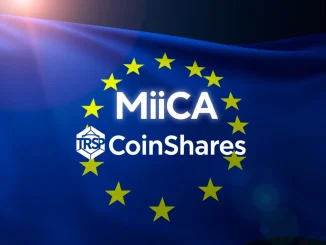
In a surprising turn of events, the crypto world is once again holding its breath as the U.S. Securities and Exchange Commission (SEC) has decided to postpone its verdict on Grayscale’s ambitious proposal for a spot Ethereum ETF that includes staking. This news, first reported by Solid Intel on X, has sent ripples through the digital asset community, leaving investors and enthusiasts alike questioning what’s next for Ethereum ETFs in the United States. Are we facing another hurdle in the journey towards mainstream crypto adoption through regulated investment vehicles?
Why is the SEC Delaying the Ethereum ETF Staking Decision?
The SEC’s decision to delay the ruling on Grayscale’s spot Ethereum ETF staking feature is not entirely unexpected, but it certainly adds another layer of complexity to the already intricate process of getting crypto-based ETFs approved in the U.S. Let’s break down what this delay could mean and why the SEC might be hesitant.
- Regulatory Scrutiny: The SEC has consistently maintained a cautious stance towards crypto assets, citing concerns about investor protection, market manipulation, and the nascent nature of the industry. Any product that involves staking, which is essentially earning rewards for holding and validating blockchain transactions, adds another dimension of regulatory consideration.
- Staking Complexity: Staking itself is a relatively new concept for traditional financial regulators. It involves locking up crypto assets to participate in the network’s operation and earn rewards. The SEC needs to thoroughly understand the risks associated with staking within an ETF structure, including custody, security, and the implications of staking rewards on ETF performance.
- Precedent Setting: Approving a spot Ethereum ETF with staking would set a significant precedent. The SEC likely wants to ensure they have a robust framework in place before greenlighting such a product, as it could pave the way for more complex crypto investment vehicles in the future.
- Market Volatility: The cryptocurrency market is known for its volatility. The SEC is probably assessing how staking within an ETF might amplify or mitigate these fluctuations and whether it aligns with investor protection mandates.
Spot Ethereum ETF: What’s the Big Deal?
For those new to the crypto ETF buzz, let’s quickly understand why a spot Ethereum ETF is such a significant development.
Currently, U.S. investors can access Bitcoin ETFs that track the spot price of Bitcoin. However, an Ethereum ETF that directly holds Ether (ETH), the native cryptocurrency of the Ethereum network, has yet to be approved. This is a crucial distinction from futures-based ETFs, which are already available for both Bitcoin and Ethereum, as spot ETFs are considered to provide more direct exposure to the underlying asset.
A spot Ethereum ETF is anticipated to:
- Simplify Investment: Make it easier for retail and institutional investors to gain exposure to Ethereum without the complexities of directly buying and managing ETH.
- Boost Liquidity: Potentially inject significant capital into the Ethereum market, increasing liquidity and market depth.
- Legitimize Crypto: Further legitimize cryptocurrencies as an asset class within traditional finance.
Grayscale and the Ethereum ETF Race
Grayscale Investments, a leading digital asset manager, has been at the forefront of pushing for crypto ETFs. They successfully converted their Bitcoin Trust (GBTC) into a spot Bitcoin ETF and are now aiming to do the same for their Ethereum Trust (ETHE) and introduce staking within it. Their efforts are closely watched as they represent a major push to bridge the gap between traditional finance and the burgeoning crypto space.
The Staking Question: Benefits and Challenges
Integrating staking into an Ethereum ETF is a novel concept that adds both potential benefits and challenges.
Benefits of Staking in an Ethereum ETF:
- Yield Generation: Staking allows ETF holders to potentially earn passive income in the form of staking rewards, enhancing the overall return of the investment. This is a key differentiator compared to spot ETFs without staking.
- Network Participation: By staking ETH, the ETF would contribute to the security and operational efficiency of the Ethereum network, aligning investor interests with the network’s health.
- Competitive Edge: Offering staking could make Grayscale’s Ethereum ETF more attractive to investors compared to potential competitors who might not offer staking.
Challenges of Staking in an Ethereum ETF:
- Custodial Risks: Securely managing staked ETH and staking rewards within an ETF structure presents custodial challenges. The SEC will want to be certain that investor assets are protected.
- Operational Complexity: Staking operations can be complex, involving technical infrastructure and expertise. ETF providers need to demonstrate they can manage this effectively.
- Regulatory Uncertainty: The regulatory landscape around staking is still evolving. The SEC needs to navigate potential uncertainties and ensure compliance with existing and future regulations.
- Liquidity Considerations: Staked ETH might be subject to lock-up periods, which could impact the ETF’s liquidity and ability to meet redemption requests.
What Does This Delay Mean for Investors?
The SEC’s delay in deciding on Grayscale’s spot Ethereum ETF staking feature introduces uncertainty into the timeline for its potential approval. For investors, this means:
- Continued Wait: Investors keen on accessing a spot Ethereum ETF with staking will have to wait longer for a final decision.
- Market Volatility: News of regulatory delays can sometimes contribute to market volatility. Ethereum’s price and the broader crypto market might experience fluctuations in response to this announcement.
- Monitor Developments: It’s crucial for investors to stay informed about further developments from the SEC and Grayscale regarding the Ethereum ETF application.
Actionable Insights: Navigating the Ethereum ETF Uncertainty
While the SEC’s delay might be disheartening for some, it’s important to remember that regulatory processes often take time. Here are some actionable insights for navigating this period of uncertainty:
- Stay Informed: Keep up-to-date with crypto news and regulatory announcements. Follow reputable sources like Solid Intel and official SEC statements.
- Diversify Your Portfolio: Don’t put all your eggs in one basket. Diversification across different asset classes can help mitigate risks associated with regulatory delays in one specific area.
- Consider Alternatives: Explore other ways to gain exposure to Ethereum, such as directly purchasing and holding ETH, or investing in companies building on the Ethereum ecosystem.
- Patience is Key: Regulatory approvals can be a lengthy process. Patience is essential in the crypto investment space.
Conclusion: The Ethereum ETF Journey Continues
The SEC’s delay on Grayscale’s spot Ethereum ETF staking decision is a reminder that the path to mainstream crypto adoption through regulated investment products is not always smooth. However, it’s also a testament to the rigorous scrutiny and due diligence that regulators are applying to this evolving asset class. While the wait continues, the demand for Ethereum ETFs remains strong, and the industry is likely to keep pushing forward. The journey towards a spot Ethereum ETF with staking in the U.S. may have encountered a detour, but it’s far from over. Stay tuned for further updates as this exciting story unfolds!



